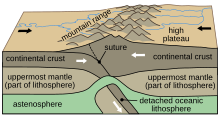Granitoid

A granitoid is a broad term referring to a diverse group of coarse-grained igneous rocks that are widely distributed across the globe, covering a significant portion of the Earth's exposed surface and constituting a large part of the continental crust [1]. These rocks are primarily composed ofquartz, plagioclase, and alkali feldspar.[2] Granitoids range from plagioclase-rich tonalites to alkali-rich syenites and from quartz-poor monzonites to quartz-rich quartzolites.[3] As only two of the three defining mineral groups (quartz, plagioclase, and alkali feldspar) need to be present for the rock to be called a granitoid, foid-bearing rocks, which predominantly contain feldspars but no quartz, are also granitoids.[3] The terms granite and granitic rock are often used interchangeably for granitoids; however, granite is just one particular type of granitoid.
Granitoids are diverse; no classification system for granitoids can give a complete and unique characterization of the origin, compositional evolution, and geodynamic environment for the genesis of a granitoid. Accordingly, multiple granitoid classification systems have been developed such as those based on: geochemistry, modal content,[jargon] emplacement depth, and tectonic regime.
Generalizations
[edit]
There are several generalizations that apply to the majority of granitoids. Typically, granitoids occur where orogeny thickens continental crust either by subduction yielding a continental arc or by convergence yielding continental collisions.[4] Generally, the evolution to granitoid magmas requires a thermal disturbance to ascent though continental crust.[4] Most granitoids are generated from crustal anatexis, the partial melting of the crust; however the mantle may contribute both heat and material.[4] Granitoids can occur coeval with volcanic rocks that have equivalent chemical composition (granite–rhyolite, syenite–trachyte, granodiorite–dacite etc.) however, these extrusive rocks are often eroded so just the plutonic rocks outcrop.[4] Granitoids can form in all tectonic environments.[4]
There are numerous exceptions to these generalizations.[5][4] For example, granitoids can form in anorogenic environments, a granitoid source rock can be from the mantle (for example, at intraplate hotspots) and the melting mechanism can be radiogenic crustal heat.[5][6][7]
References
[edit]- ^ Tomás, R.; Cano, M.; Pulgarín, L. F.; Brotóns, V.; Benavente, D.; Miranda, T.; Vasconcelos, G. (2021-11-01). "Thermal effect of high temperatures on the physical and mechanical properties of a granite used in UNESCO World Heritage sites in north Portugal". Journal of Building Engineering. 43: 102823. doi:10.1016/j.jobe.2021.102823. ISSN 2352-7102.
- ^ "USGS: Mineral Resources On-Line Spatial Data: Granitoid".
- ^ a b Streckeisen, A. (1974). "Classification and Nomenclature of Plutonic Rocks: Recommendations of the IUGS Subcommission on the Systematics of Igneous Rocks". Geologische Rundschau (in German). 63 (2): 773–86. Bibcode:1974GeoRu..63..773S. doi:10.1007/BF01820841. S2CID 130569261.
- ^ a b c d e f Winter, John D. (2014). Principles of igneous and metamorphic petrology. Harlow. p. 402. ISBN 978-1-292-02153-9. OCLC 890442947.
{{cite book}}: CS1 maint: location missing publisher (link). - ^ a b Clarke, D. B. (1992) Granitoid Rocks, Chapman & Hall, London.
- ^ Pitcher, W. S. 1982. Granite type and tectonic environment. In Hsu, K. J. (ed.) Mountain Building Processes, 19–40. London: Academic Press.
- ^ Barbarin, Bernard (1990). "Granitoids: Main petrogenetic classifications in relation to origin and tectonic setting". Geological Journal. 25 (3–4). Wiley: 227–238. Bibcode:1990GeolJ..25..227B. doi:10.1002/gj.3350250306. ISSN 0072-1050.
